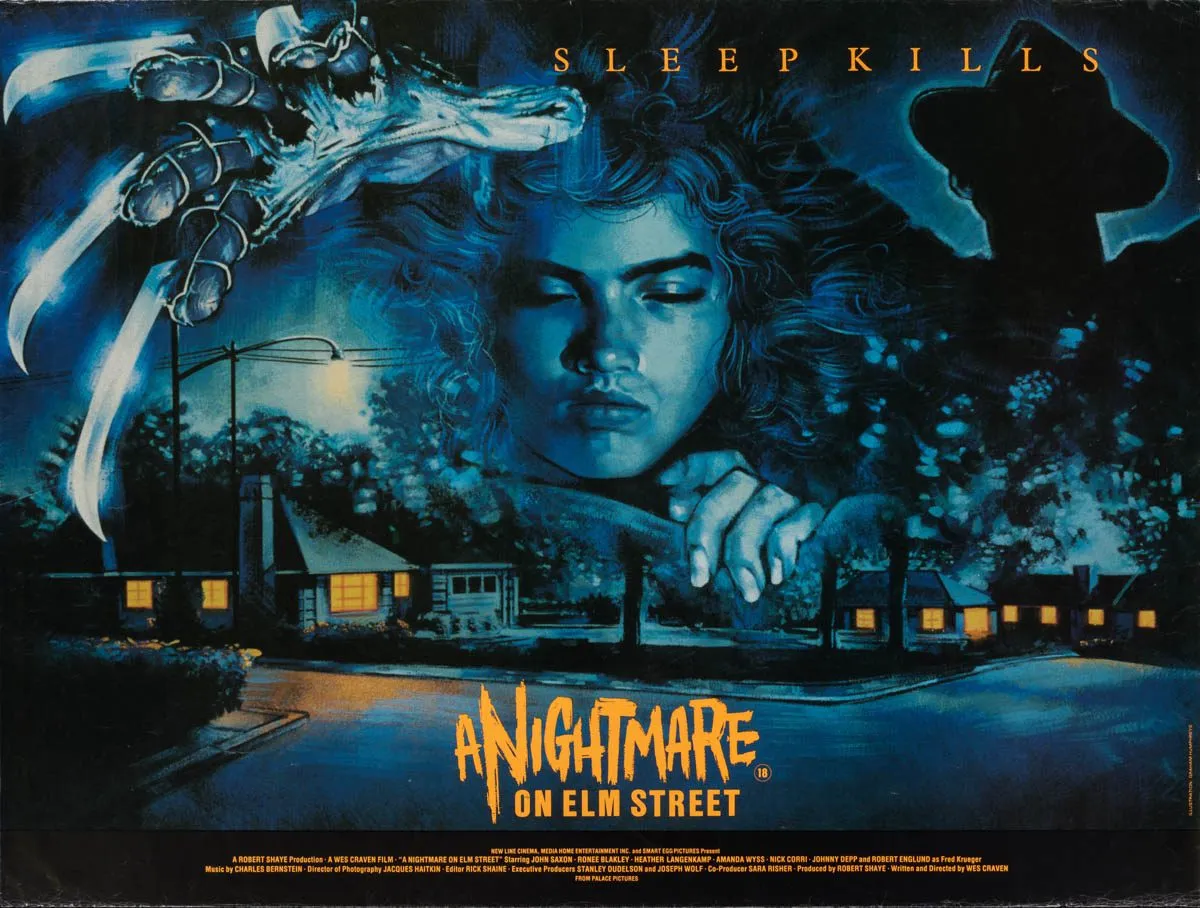“A Nightmare on Elm Street 1984”

“A Nightmare on Elm Street” (1984) is a groundbreaking horror film written and directed by Wes Craven, introducing one of the most iconic villains in horror history, Freddy Krueger. The film combines supernatural terror with real-world fears, using dreams as the terrifying battleground for the characters’ survival. Freddy Krueger, played by Robert Englund, would go on to become a pop culture icon, making A Nightmare on Elm Street one of the most influential slasher films of the 1980s and sparking a long-running franchise.
Plot Overview
The story takes place in the fictional town of Springwood, where a group of teenagers begins experiencing disturbing nightmares featuring a horribly burned man with a bladed glove. Nancy Thompson (Heather Langenkamp) is one of these teens, and she soon learns that the man in her dreams is Freddy Krueger, a sadistic child killer who was murdered by the parents of the town after being released from prison on a technicality.
Freddy, now a vengeful spirit, haunts the dreams of the town’s teenagers, killing them in their sleep, which results in their deaths in real life. As Nancy’s friends begin dying one by one in increasingly gruesome ways, she realizes that Freddy can only hurt them when they are asleep. Nancy must figure out how to defeat Freddy by staying awake or finding a way to bring him into the real world, all while dealing with the disbelief of the adults around her.
The film’s climax sees Nancy confronting Freddy directly, using her knowledge of dreams and her resourcefulness to outsmart him. By turning her back on Freddy and refusing to acknowledge his power, she ultimately strips him of his ability to harm her—at least temporarily.
Key Characters
- Nancy Thompson (Heather Langenkamp): The film’s protagonist, Nancy is a resourceful and strong-willed teenager who takes the lead in figuring out how to defeat Freddy Krueger. Unlike many horror movie victims, Nancy is a proactive character who doesn’t just run from the killer—she fights back.
- Freddy Krueger (Robert Englund): Freddy is the film’s central villain, a monstrous figure with a burned face, a dirty red-and-green sweater, and a glove fitted with razor-sharp blades. He haunts the dreams of teenagers and kills them in increasingly terrifying and inventive ways. Freddy’s ability to invade dreams and his dark sense of humor make him a unique and fearsome antagonist.
- Glen Lantz (Johnny Depp): Glen is Nancy’s boyfriend, played by Johnny Depp in his film debut. Despite Nancy’s warnings about Freddy, Glen struggles to believe her, which ultimately leads to his own demise in one of the film’s most iconic death scenes.
- Marge Thompson (Ronee Blakley): Nancy’s mother, who is harboring a secret about Freddy Krueger’s past. Her alcoholism and inability to protect Nancy reflect the ineffectiveness of the adults in the film.
- Lt. Donald Thompson (John Saxon): Nancy’s father and a police lieutenant, he also refuses to believe in the supernatural threat facing his daughter. His disbelief is emblematic of the generational divide between the teens and their parents in the film.
Themes
- The Power of Dreams: One of the film’s central themes is the idea that dreams can have real-world consequences. Freddy Krueger’s power is derived from the dream world, and he uses it to manipulate and control his victims. The movie plays on the idea that the most vulnerable time is when we are asleep, and therefore helpless.
- Guilt and Revenge: Freddy’s origins as a child killer who was burned alive by the parents of Springwood adds layers of guilt and revenge to the story. The parents’ vigilante justice has horrific consequences for their children, as Freddy exacts his revenge on the next generation. The film raises questions about collective guilt and the price of revenge.
- The Ineffectiveness of Adults: Throughout the film, the adults in Nancy’s life—her parents, the police, and other authority figures—are unable to understand or help her. This theme of adult ineffectiveness is common in Craven’s films, where young characters must confront dangers on their own while their parents and other adults either refuse to believe them or are powerless to act.
- Survival and Agency: Unlike many other slasher films of the era, where the “final girl” is often portrayed as a passive victim, Nancy Thompson takes control of her situation. She actively researches Freddy, sets traps, and confronts him on her own terms. The film emphasizes personal agency and the power to fight back against seemingly insurmountable odds.

Visual Style and Effects
Nightmare on Elm Street is famous for its inventive and surreal dream sequences, which blur the lines between reality and fantasy. The film uses practical effects to create some of the most iconic visuals in horror history, including:
- Tina’s Death: One of the most memorable sequences in the film is the death of Nancy’s friend Tina (Amanda Wyss), who is dragged up the walls and across the ceiling of her bedroom by an unseen force, while Freddy slashes at her. The effect was achieved using a rotating room, and it remains a stunning and terrifying moment.
- Glen’s Death: Johnny Depp’s character, Glen, is killed when he is sucked into his bed, followed by a geyser of blood erupting from the hole. This shocking and grotesque death scene is one of the film’s most iconic moments.
- Freddy’s Design: Freddy’s burned, disfigured face and his bladed glove are now iconic in the horror genre. His menacing yet darkly humorous personality, combined with his gruesome appearance, sets him apart from other horror villains of the time.
Tone and Atmosphere
The film masterfully blends tension, terror, and surrealism. The line between dreams and reality is constantly blurred, making the audience question what is real and what is part of the dream world. The dream sequences are particularly nightmarish, using strange camera angles, unsettling sound effects, and terrifying imagery to create a sense of inescapable dread.
Freddy’s presence looms large throughout the film, even when he is not physically on screen, and his dream manipulation makes him feel omnipresent. Unlike traditional slasher villains who chase their victims through physical space, Freddy attacks in the one place his victims should feel safe—their dreams.
Reception and Legacy
Nightmare on Elm Street was both a critical and commercial success, grossing over $57 million worldwide on a modest budget of $1.8 million. It is widely considered one of the best horror films of all time, praised for its originality, special effects, and the creation of Freddy Krueger, who became one of the most recognizable horror icons.
The film revitalized the slasher genre, which was beginning to stagnate by the mid-1980s, and its success led to numerous sequels, crossovers (such as Freddy vs. Jason), a TV series, and a 2010 remake. Freddy Krueger, with his unique ability to haunt dreams, stood out from other horror villains and became a cultural touchstone, known for both his terrifying nature and his sardonic sense of humor.
Conclusion
A Nightmare on Elm Street (1984) remains a landmark in horror cinema. Wes Craven’s innovative use of dreams as a conduit for terror, combined with Robert Englund’s unforgettable portrayal of Freddy Krueger, set it apart from other slasher films of its era. The film’s blend of supernatural horror, inventive effects, and psychological tension created a new standard for horror films, and its influence can still be felt in the genre today. For fans of horror, A Nightmare on Elm Street is an essential viewing experience that remains as terrifying and imaginative now as it was upon its release.











